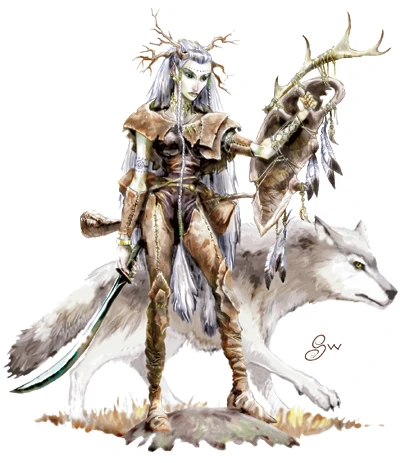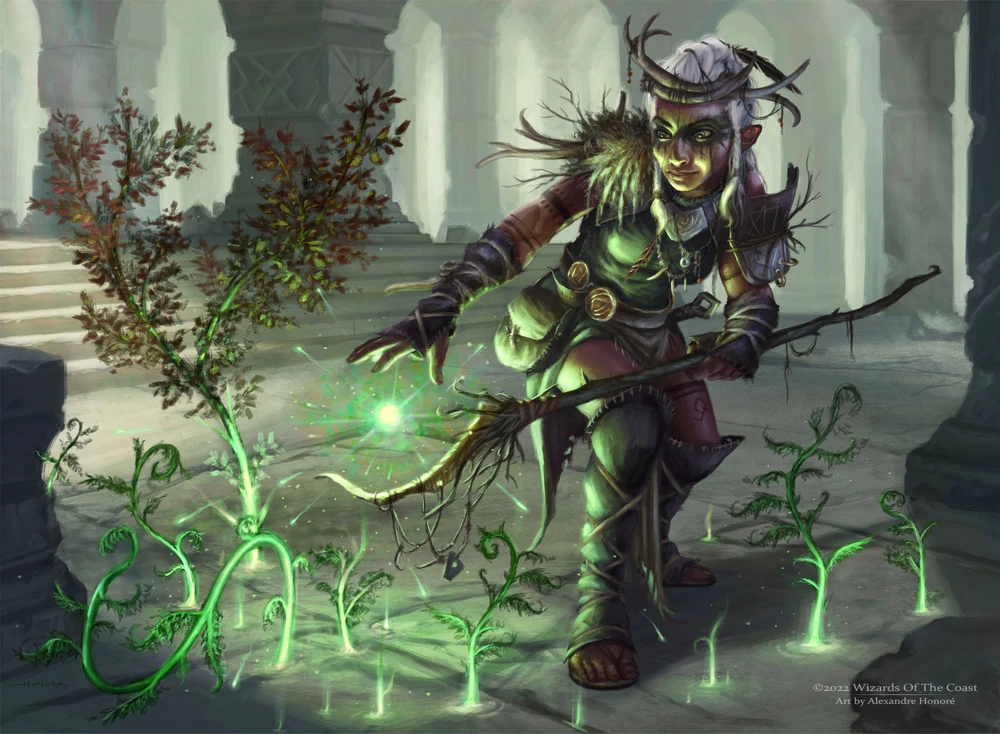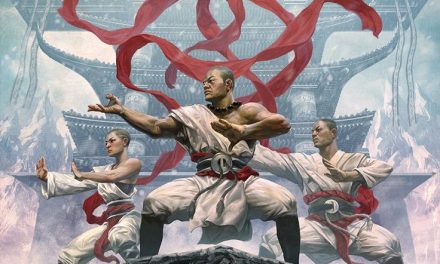The Circle of the Land Druid is one of two subclass options available to players in the 5e Player’s Handbook.
Circle of the Land Druids gather in places of sacred power to exchange secrets and observations. Beneath ancient trees and curious pillars of stone, they seek wisdom to guide others toward a life of balance with nature.
These whispered conversations can potentially go on to influence communities and kings. After all, the Circle of the Land Druid works as a type of ambassador between the old ways and the new.
For those seeking to maintain the long-held oral traditions that guide civilization to live in harmony with nature, this is the full guide to the Circle of the Land Druid in D&D 5e.
What is the Circle of the Land Druid?
Circle of the Land Druids serve as sages and keepers of ancient traditions and wisdom.
While many members of this Circle are notoriously reclusive, some still find their roles as advisors to rulers or as priests in villages that still practice the Old Faith.
The Circle of the Land’s rites are as mysterious as one might expect. Druids who take this subclass find that their abilities are naturally influenced by the environment in which they were initiated.
Whether the Druid embodies the might of the mountains, deception of the desert, or otherwise, they are eternally tied to the land itself. As they grow in power, their connection to this land deepens and fills their soul.
This gives the Circle of the Land Druid the understanding that they desire. With this wisdom, they go forth to preserve the balance of nature.
Only a fool would defy the words of such a Druid!
The Circle of the Land Druid appears in the 5e Player’s Handbook alongside the Circle of the Moon subclass.
Role in the Party
Of all of the Druid subclasses, the Circle of the Land Druid is the one that is most heavily geared toward spellcasting. Because of this, they will largely be staying in the party’s backline when combat breaks out.
When comparing the Circle of the Land Druid to another dedicated caster like the Wizard, it’s difficult to do an apples-to-apples comparison.
The Druid’s spell list doesn’t incline towards blasting enemies to kingdom come like their Wizard counterparts. However, it does contain several useful buffs, heals, and AoE spells that will certainly be welcomed by the party.
As the Circle of the Land Druid levels up, their abilities become more consistent and they bring some out-of-the-box problem-solving to the table.

Circle of the Land Druid Abilities
Unlike the other Druid subclasses, the Circle of the Land Druid’s features are pretty on-the-nose for the most part. The most important abilities to be mindful of when leveling are your Circle Spells at levels 3, 5, 7, and 9.
So let’s take a look at the Circle of the Land Druid features!
Bonus Cantrip (Level 2)
Upon becoming a Circle of the Land Druid at 2nd level, you get an additional cantrip!
You learn one additional Druid cantrip of your choice.
This may not sound like much, but it’s actually very useful!
Typically, Druids only start with 2 cantrips versus Wizards and Clerics who start with 3. With this bonus cantrip, you are back to being right alongside other full casters while still getting your Wild Shape and weapon proficiencies!
Related: The Best Druid Spells by Level in D&D 5e!
Natural Recovery ( Level 2)
Some might say that the Circle of the Land Druid borrowed this ability from the Wizard’s book, but it could possibly be the other way around…
In either case, the Circle of the Land Druid’s Natural Recovery ability functions the same as the Wizard’s Arcane Recovery ability.
During a short rest, you choose expended spell slots to recover. The spell slots can have a combined level that is equal to or less than half your Druid level (rounded up), and none of the slots can be level 6 or higher.
You can’t use this feature again until you finish a long rest.
So, for example, the Druid uses their Natural Recovery while the party is taking a short rest.
Because the Druid is level 5, they can recover 3 levels of spell slots (half of five is 2.5, rounded up is 3). This can be one 3rd level slot, a 2nd and a 1st level slot, or three 1st level slots.
This recovery is key to the ability of the Circle of the Land Druid to stay consistently helpful to the party. Even better is the fact that this ability scales great as the Druid levels up since the recovered slots are based on the Druid’s level!
Circle Spells (Level 3)
Based on the environment that you choose at third level, you gain special spells related to that chosen environment. You gain additional spells related to that environment at levels 5, 7, and 9.
There’s quite a bit to cover here, so we’ll come back to the Circle Spells of the Circle of the Land Druid in just a bit! With 8 different environment options, the topic deserves its own section!

Land’s Stride (Level 6)
Once you hit level 6 as a Circle of the Land Druid, you gain the Land’s Stride ability.
Moving through nonmagical difficult terrain costs you no extra movement.
You can also pass through nonmagical plants without being slowed by them and without taking damage from them if they have thorns, spines, or a similar hazard.
In addition, you h ave advantage on saving throws against plants that are magically created or manipulated to impede movement, such as those created by the Entangle spell.
This isn’t necessarily a huge, class-defining buff, but it’s nice to have when the situations arise.
Campaigns that see you mostly trudging through underground dungeons probably won’t give you much opportunity to really use this ability. However, campaigns with lots of wilderness exploring will give you plenty of use for this!
Related: The Full Guide to Wild Shape in D&D 5e
Nature’s Ward (Level 10)
Circle of the Land Druids gain the Nature’s Ward feature at level 10.
The description is pretty short, sweet, and to the point. However, there are some implications that we need to address while we’re talking about this.
You can’t be charmed or frightened by elementals or fey, and you are immune to poison and disease.
Nature’s Ward is particularly useful against Fey. Many Fey creatures have effects that can cause you to become charmed or frightened. While you will be stronger than most Fey creatures at level 10, that just means that they won’t be able to rely on their usual tricks.
It’s less useful against elementals, though.
Elementals are primarily known for beating adventurers into the ground, setting them on fire, and/or drowning them before yeeting their corpses over the horizon. Charms and fear effects aren’t commonly part of their M.O.
But the coolest part of this feature is the poison immunity.
Not only are you immune to the poisoned condition, but you are also immune to poison damage as well! Poison is pretty common throughout the game, so having outright immunity is brilliant.
You have to admit, it would be pretty epic to just shrug off a Green Dragon’s poison breath attack!
Finally, disease is considerably less common than poison, but it is devastating when it happens. Not having to worry about whatever the latest plague your DM has cooked up is a nice feeling, isn’t it?
Nature’s Sanctuary (Level 14)
Finally, we come to the Land Druid’s capstone feature, Nature’s Sanctuary!
The Circle of the Land Druid gets this feature at level 14. Depending on your campaign, this could either be your best friend or instead be completely underwhelming.
When a beast or plant creature attacks you, that creature must make a Wisdom saving throw against your Druid spell save DC.
On a failed save, the creature must choose a different target, or the attack automatically misses.
On a successful save, the creature is immune to this effect for 24 hours.
The creature is aware of this effect before it makes its attack against you.
The biggest problem with this ability is that there just really aren’t a large number of beasts and plant creatures that you will be fighting at level 14. It’s not impossible, but it’s unlikely.
The Tyrannosaurus Rex is one of the strongest beasts and has a CR of 8. Treants are the strongest plant creature with a CR of 9 and are generally good-aligned creatures. The next strongest plant creature would be the Corpse Flower with a CR of 8.
However, your game may vary. Nothing stops the DM from homebrewing some epic-level beasts or plant creatures for your group to fight.
It’s not a useless ability, but it’s one that becomes a lot more situationally useful than you might initially think.

Circle of the Land Druid Circle Spells
As I mentioned earlier, there’s a lot to cover when it comes to the Circle of the Land Druid and their Circle Spells.
These spells are based on the environment that you choose upon hitting level 3. Because the Circle of the Land Druid is so spellcasting-heavy, this is a pretty important choice for you to make at a fairly low level.
Because of that, let’s take a closer look at each of the 8 environments available to the Circle of the Land Druid. You can find these on page 68 of the PHB.
How Do Druid Circle Spells Work?
First things first, let’s cover how these Circle Spells actually work.
Each environment has a total of 8 spells that count as Circle Spells for the Circle of the Land Druid. The Druid gets these 2 at a time at levels 3, 5, 7, and 9.
The Circle Spells provided by the chosen environment are always prepared. Furthermore, these spells don’t count against the number of spells that your Druid can prepare per day.
If a Circle Spell is not typically on the Druid spell list, it counts as a Druid spell for you.
You may choose an environment that gives you several spells that aren’t conventionally available to Druids so that you have some extra variety. However, there is nothing wrong with sticking to the classics and choosing a Circle that lets you always have some classic Druid spells at the ready.
It’s worth mentioning beforehand though that none of these options are necessarily awful. Some are, in my opinion, better than others, but they all give you extra spells that you have prepared each day.
It’s always better to have a free spell prepared and not need it than to need it and not have it prepared.
That said, let’s dive in!
Arctic
Arctic Circle Spells put a focus on control spells that impede your enemies. As you level, there is some extra utility and damage.
It’s worth noting that nearly all of these spells require concentration.
| Druid Level | Circle Spells |
| 3 | Hold Person , Spike Growth |
| 5 | Sleet Storm , Slow |
| 7 | Freedom of Movement , Ice Storm |
| 9 | Commune with Nature , Cone of Cold |
Coast
As you might expect, the Coastal Circle Spells are incredibly water-based.
Having several spells dedicated to keeping you mobile is useful in sticky situations. However, if your campaign isn’t going to be taking place on or near water, you are severely limiting yourself.
Otherwise, it’s a solid pick!
| Druid Level | Circle Spells |
| 3 | Mirror Image , Misty Step |
| 5 | Water Breathing , Water Walk |
| 7 | Control Water , Freedom of Movement |
| 9 | Conjure Elemental , Scrying |
Desert
I have a weakness for the Desert Circle. Illusions are just so fun!
These spells work best defensively (especially Protection From Energy!), though the damage options aren’t bad picks!
| Druid Level | Circle Spells |
| 3 | Blur , Silence |
| 5 | Create Food and Water , Protection From Energy |
| 7 | Blight , Hallucinatory Terrain |
| 9 | Insect Plague , Wall of Stone |
Forest
If we’re being honest here, the Forest Circle really has nothing to offer. With the exception of Divination, all of these spells are already options on the Druid’s spell list.
While it’s convenient to have spells always prepared, these aren’t spells that will likely get a ton of opportunities to shine either!
There’s a decent mix of defense, utility, and information gathering, though. So that’s good?
Personally, I’d pass on this one.
| Druid Level | Circle Spells |
| 3 | Barkskin , Spider Climb |
| 5 | Call Lightning , Plant Growth |
| 7 | Divination , Freedom of Movement |
| 9 | Commune with Nature , Tree Stride |
Grassland
The Grassland Circle is certainly one of the standout options when choosing your Circle Spells. It feels like a nice balance between useful druid spells and fun spells that Druids typically wouldn’t be able to have.
While this Circle doesn’t have much in the way of damage until Insect Plague at level 9, the utility is great!
| Druid Level | Circle Spells |
| 3 | Invisibility , Pass Without Trace |
| 5 | Daylight , Haste |
| 7 | Divination , Freedom of Movement |
| 9 | Dream , Insect Plague |
Mountain
I love the Mountain Circle!
Not only do you get some solid utility out of spells like Spider Climb and Stone Shape, but getting Lightning Bolt lets you finally have a reliable heavy-hitter of a spell in your pocket at all times!
| Druid Level | Circle Spells |
| 3 | Spider Climb , Spike Growth |
| 5 | Lightning Bolt , Meld Into Stone |
| 7 | Stone Shape , Stoneskin |
| 9 | Passwall , Wall of Stone |
Swamp
The Swamp Circle isn’t bad. They certainly start out strong!
However, the options at levels 7 and 9 are very situationally useful. If you expect your game to stay in the low and mid-level range, this could be a good option for you. Beyond that, it’s so-so.
| Druid Level | Circle Spells |
| 3 | Darkness , Melf’s Acid Arrow |
| 5 | Water Walk , Stinking Cloud |
| 7 | Freedom of Movement , Locate Creature |
| 9 | Insect Plague , Scrying |
Underdark
If forced to choose a favorite Circle, I would be hard-pressed to choose between the Underdark and the Mountain.
Of the two, the Underdark is certainly the most powerful overall. Every one of the spells on this list is a high-impact spell.
Every one of these spells is good to have at the ready. By the time you’re casting Greater Invisibility or Cloudkill, you’ll feel like an absolute force of nature.
Which is convenient because, you know… you are…
| Druid Level | Circle Spells |
| 3 | Spider Climb , Web |
| 5 | Gaseous Form , Stinking Cloud |
| 7 | Greater Invisibility , Stone Shape |
| 9 | Cloudkill , Insect Plague |
Is the Circle of the Land Druid Good?
The Circle of the Land Druid isn’t necessarily bad, but it does fill a specific niche. They can certainly be invaluable to the party, but they admittedly lack the distinct flavor of other Circles.
Depending on what environment you choose for your Circle Spells and the abilities of your party, some of these Druids are naturally going to be more generally useful than others.
All in all, the Circle of the Land Druid is most comparable to the Wizard.
However, where the Wizard has a large number of spells that bring utility and large amounts of damage to the table, the Circle of the Land Druid brings healing and a large amount of AoE control spells.
The biggest downside is that a large number of the Druid’s spells require concentration which means that you won’t be spell-slinging in the same way as a Wizard.
With the exception of your Circle spells, any Druid subclass could cast these same spells in addition to their abilities.
Meanwhile, the Circle of the Land Druid doesn’t get abilities that increase the potency of their spellcasting, only the variety of their available spells.
However, Natural Recovery is a great ability though and helps you get more mileage out of your spell slots.
Plus, getting access to some spells that Druids normally don’t get (like Lightning Bolt from the Mountain Circle or Greater Invisibility from the Underdark Circle) does help broaden the Druid’s role in the party a bit.
Related: Ranking Every Druid Subclass in D&D 5e!
Conclusion – Circle of the Land Druid in D&D 5e
So that wraps up this look at the Circle of the Land Druid for D&D 5e.
While this subclass probably won’t be making the top of anyone’s list for druid subclasses, it does offer some unique twists to the standard Druid character.
What are your thoughts on the Circle of the Land Druid? Let me know what you think in the comments!
Also, don’t forget to check out our Complete Druid Guide for D&D 5e! It covers everything you need to fully channel the power of nature on your adventures!









